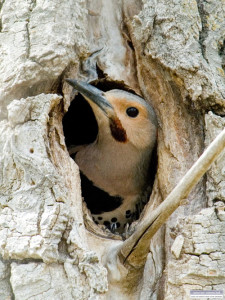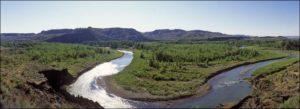Managing salt cedar and Russian olive on Montana Waterways
As part of our ongoing River Initiative, Montana Audubon hosted a workshop, Managing Salt Cedar and Russian olive on Montana Waterways. This page contains PowerPoint presentations, summary information, the handouts presenters brought to the workshop, and a few other items that participants wanted to share. Additional information will be added to this page as we receive permission to post.

Northern Flicker. Cottonwoods are used by cavity nesting birds (woodpeckers, bluebirds, Tree Swallows, chickadees, and more) for nesting. Russian olive and salt cedar generally cannot be used by these birds.
Workshop Information
PowerPoint Presentations Given at Workshop:
- Peter Lesica PowerPoint: Understanding Montana Rivers and Woody Invasives
- Erin Espeland PowerPoint: Russian Olive Impacts
- Rachel Frost PowerPoint: Salt Cedar Impacts
References and Literature to Share
Mapping Information
- Application for EDDMapS West (NOTE: this application can be loaded on your phone or computer. It is a national web-based mapping system for documenting invasive species distribution and the information is shared with the Montana Natural Heritage Program (see below)
- Montana Natural Heritage Program website:
- Home Page
- Montana GIS Data List (NOTE: the Russian Olive GIS layer will be posted by November 8, 2017)
- Ecology Reports (NOTE: the report Predicting the Distribution of Russian Olive Stands in Eastern Montana Valley Bottoms Using NAIP Imagery will be posted by November 8, 2017)
Ecological Research Conducted in Montana
- Auble, Gregory, et. al. 2012. Woody Riparian Vegetation near Selected Streamgages in the Western United States. NOTE: USGS botanists visited 456 streamgage sites in the western US between 1996-2002; occupancy and aerial cover of woody riparian species was recorded; an estimated 49 sites were visited in Montana.
- Espeland, Erin, Tatyana Rand, and Kevin Delaney. 2014. Russian olive fruit production in shelterbelt and riparian populations in Montana.
- Hybner, Roger and Erin Espeland. 2014. Russian olive Elaragnus angustifolia Effect of Seed Burial Depth on Seedling Emergence and Seed Viability. NOTE: this research study addresses Russian olive seed viability – an issue discussed at the conference.
- Lesica, Peter and Scott Miles. 1999. Russian olive invasion into cottonwood forests along a regulated river in north-central Montana.
- Lesica, Peter and Scott Miles. 2001. Natural History and Invasion of Russian Olive Along Eastern Montana Rivers.
- Lesica, Peter and Scott Miles, 2001b. Tamarisk Growth at the Northern Margin of its Naturalized Range in Montana, USA.
- Lesica, Peter and Scott Miles. 2004. Beavers indirectly enhance the growth of Russian olive and tamarisk along eastern Montana rivers.
- Lesica, Peter and Scott Miles. 2004b. Ecological strategies for managing tamarisk on the C.M. Russell National Wildlife Refuge, Montana, USA.
- Pearce, Cheryl and Derald Smith. 2001. Plains Cottonwood’s Last Stand: Can It Survive Invasion of Russian Olive onto the Milk River, Montana Floodplain?
- Russian Olive Removal and Restoration Workshop. 2016. This booklet includes a summary of research being conducted at Fort Keogh (Montana).
Summary of Removal Projects in Montana:
- Missouri River Conservation Districts Council:
- Yellowstone River Conservation District Council:
- Yellowstone River Cumulative Effects Analysis at a Glance
- Short video on a Russian olive removal project on Yellowstone River: http://www.co.yellowstone.mt.gov/publicworks/weed/Projects/RussianOlive.asp.
Wildlife Impacts (With an Emphasis on Birds):
- Bateman, Heather and Eben Paxton. 2009. Saltcedar and Russian Olive Interactions with Wildlife.
- Fischer, Richard, e.t., al. 2012. Bird Community Response to Vegetation Cover and Composition in Riparian Habitats Dominated by Russian Olive (Elaeagnus angustifolia).
- Henricks, P, S. Lenard, and L. Vance. 2012. Bat Activity In Riverine Stands Of Native Plains Cottonwood And Naturalized Russian Olive In Southeastern Montana:
- Nosan, A., Megan Fylling, and Kristina Smucker. 2009. Distribution of Birds Along the Missouri and Madison River Corridors.
- Noson, A. and A. D. Flesch. 2015. Trends in populations of breeding birds and habitat conditions in riparian areas along the Madison and Missouri Rivers, Montana 2004-2015.
- Seaman, Amy. 2016. Missouri River Surveys Year 2: Cottonwood regrowth, cuckoos, and canoes.
Other Information to Share:
- 2015 Annotated Bibliography of Russian Olive and Salt Cedar (focused on ecology and wildlife)
- Reynolds, Lindsay and David Cooper. 2010. Environmental tolerance of an invasive riparian tree and its potential for continued spread in the southwestern US. NOTE: This research addresses two questions: “(1) is Russian olive able to tolerate drier and shadier conditions than cottonwood and tamarisk? (2) Can tamarisk and cottonwood facilitate Russian olive invasion?”
- Shafroth, P., Curtis Brown, and David Merritt. 2010. Saltcedar and Russian olive control demonstration act science assessment.
Links to Other Meetings Addressing Russian Olive and Salt Cedar
- 3rd Northern Rockies Invasive Plants Council Conference (2014)
- 4th NRIPC Conference 17-20 October, 2016, Boise Centre, Boise, ID
For Questions or More Information: Contact Amy Seaman [email protected]; 406.443.3949
